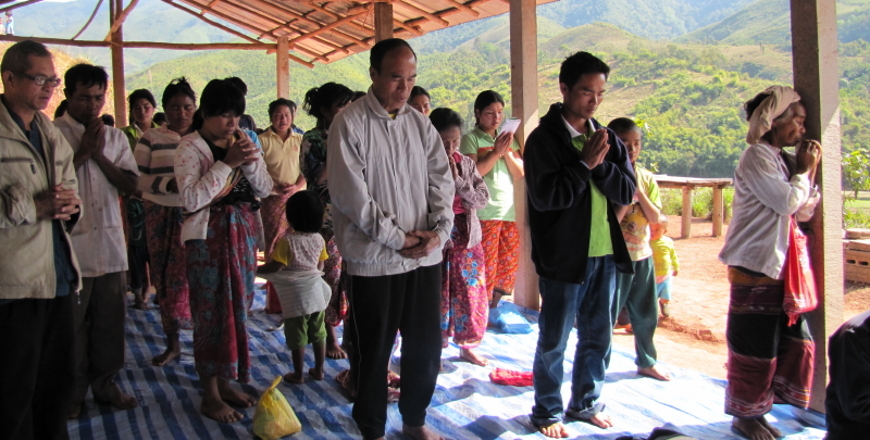The Lua people are a marginalised group who, over time, migrated from neighbouring Laos and settled in very difficult terrain on the Thai/Laos border. They are not Thais and do not speak their language (lua dialect has not yet been officially recorded). These are the animistic people, controlled by spirit worship and resultant fear. More […]
The Lua people are a marginalised group who, over time, migrated from neighbouring Laos and settled in very difficult terrain on the Thai/Laos border. They are not Thais and do not speak their language (lua dialect has not yet been officially recorded). These are the animistic people, controlled by spirit worship and resultant fear.
More than 140,000 people are estimated to live in this remote region. Only 20 per cent can read and write.
Most Lua live in villages on the sides of the steeply sloping mountains that divide the region into a series of sharp valleys. The reddish soil appears to be of poor quality. The main crop is dry mountain rice with some maize. A significant amount of native vegetation has been cleared.
Many villages are situated at more than 2000 metres above sea level. The days can be hot but nights and mornings cold, damp and harsh. Leeches are often present on the ground, where people sit.
People generally live in small thatched buildings perched on stilts. The section below the house provides a dry place to store firewood and shelter the chooks and dogs that freely roam. In some cases, timbers have been stored until they can be built into more permanent housing.
These homes are dark and filled with smoke from fires used for warmth and to cook meagre meals. Cramped and sparse, houses also provide storage for bags of rice and a few implements used for cooking and harvesting.
Village life is communal. Alcohol and drug problems abound. Combined with issues of repressed anger, alcoholism is among the causes of serious fighting. Children start drinking as young as 10. Girls can be married off at the same age.
Due to insufficient rainfall recently, rice harvests have been affected – forcing many of the younger people and parents to leave villages and head to the cities to find limited manual work (with poor pay and conditions). This has affected the elderly people left behind, who must care for the younger children. Many older villagers are often neglected and live on very limited food supplies, in cold and difficult circumstances.
The health of the people is poor due to various factors such as diet (they mainly eat vegetables; not much protein), soil deficiency, substance abuse, remoteness, physical ailments due to harsh and constant manual labour, animistic beliefs imposing destructive rules and poor housing conditions, amongst others.
Women do most of the work. In order to provide their thatched homes with heating and cooking fuel, they are forced to cut timber in distant regions and carry it – in heavy bundles, on their backs – up sheer paths to their villages.
Over time, the Lua migrated to Thailand from neighbouring Laos, but still retained strong connections across the border. Regular fighting between the Thai and Laotian communists during the 60s and 70s resulted in the Lua people having their culture largely destroyed, particularly those under communist control. The Nan province lay in part of, what was known in the 60s as, the opium growing ‘Golden Triangle’, which had a huge impact on their culture. They were subject to guerrilla warfare and even today, people will not venture into particular areas due to the fear of land mines. They are considered ‘displaced persons’ and ethnically, are very different to the Thai people. They do not speak the Thai language and hold largely animistic beliefs which are controlled by spirit worship and fear. The Lua are generally discriminated against by most of Thai society, which has resulted in a lower standard of living.
Living from day to day, the Lua people have just survival on their minds. But this is rapidly changing as hope emerges in the form of their newfound faith in Jesus Christ. Since 2005, over 1000 Lua in the area have been baptised into the Evangelical Lutheran Church of Thailand and receive Holy Communion regularly. This has seen more and more Lua put their trust in God and has brought about positive changes to their lives. Thai Lutheran Pastor Amnauy lives in the region, teaches and ministers to the people regularly, assisting them to build up parts of their lost culture and supporting them in their love for Jesus. Pastor Simon Mackenzie visits regularly providing much needed teaching, support and Holy Communion to the community. The Lutheran Church of Australia supports St. Mark’s Lutheran Church with their annual mission trips to the region which have been in operation since 2009. Many volunteers over the years, have donated their time and skills by putting their love of Jesus into practice with the Lua people.
Many of our partner churches are working in new territory for the kingdom of God; therefore, spiritual attack is their everyday reality. As a member of a congregation, school, or family, or a couple or individual, you are invited to commit to praying for our partners in mission. For regular prayer point updates, go to www.lca.org.au/international-mission/act-now/pray
Read more stories about our partner churches in Thailand at https://www.lcamission.org.au/category/stories/international-partners/thailand/


0 Comment